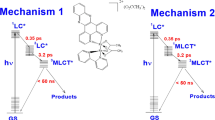Abstract
The semireduced form (Adr) of the anti-tumour agent adriamycin is implicated in cardiotoxic side effects. Adr, prepared by reduction with e −aq and CO −2 , has pK values at 2.9 and 9.2. In the pH range ∼6–11, Adr is relatively stable, existing in equilibrium with Adr and the hydroquinone, the latter subsequently losing the sugar within ∼100 ms. The E 17 of Adrais −328 mV, so at equilibrium the reaction O −2 + Adr⇋O2 + Adr lies well over to the left. The relative yields of O2(1Δg) formed via energy transfer from triplet excited components of haematoporphyrin derivative, the drug used in photodynamic therapy, have been measured by observations of the phosphorescence emission at 1270 nm. The measurements suggest that the most active component, dihaematoporphyrin ether or ester, is comparatively ineffective itself photodynamically, but may serve as a pool for the more effective haematoporphyrin and hydroxyethylvinylporphyrin to act inside the cancer cell. One-electron oxidation of dopa, through N .3 or photoionization, leads to the melanin precursor dopachrome via dopasemiquinone and dopaquinone. The latter reacts with cysteine to form cysteinyldopa, a marker for malignant melanoma metastasis. N .3 —initiated oxidation of cysteinyldopa proceeds via a different mechanism involving the corresponding semiquinone, quinone and a quinone-imine which rearranges to a more stable benzothiazole.
Similar content being viewed by others
References
E. J. LAND, T. MUKHERJEE, A. J. SWALLOW, J. M. BRUCE, Arch Biochem. Biophys., 225 (1983) 116.
E. J. LAND, T. MKHERJEE, A. J. SWALLOW, J. M. BRUCE, Br. J. Cancer, 51 (1985) 515.
T. J. DOUGHERTY, C. R. C. Critical Reviews in Oncology/Hematology, 2 (1984) Issue 2, 83.
T. J. DOUGHERTY, W. R. POTTER, K. R. WEISHAUPT, in Porphyrins in Tumor Phototherapy, A. ANDREONI, R. CUBEDDU (Eds), Plenum, New York, 1984, p. 23.
D. KESSEL, Intern. Meeting on Porphyrins as Phototherapeutic agents for tumors and other diseases Alghero, Sardinia, Italy, May 1985, Abstracts.
R. V. BENSASSON, E. J. LAND, Photochemical and Photobiological Reviews, Vol. 3, K. C. SMITH (Ed), Plenum, New York, 1978, p. 163.
J. P. KEENE, D. KESSEL, E. J. LAND, R. W. REDMOND, T. G. TRUSCOTT, Photochem. Photobiol., 43 (1986) 117.
A. A. GORMAN, I. HAMBLETT, M. A. J. RODGERS, J. Amer. Chem. Soc., 106 (1984) 4679.
A. KELLMANN, J. Phys. Chem., 81 (1977) 1195.
M. R. CHEDEKEL, E. J. LAND, A. THOMPSON, T. G. TRUSCOTT, J. Chem. Soc. Chem. Commun., (1984) 1170.
S. STEENKEN, P. NETA, J. Phys. Chem., 86 (1982) 3661.
A. THOMPSON, E. J. LAND, M. R. CHEDEKEL, K. V. SUBBARAO, T. G. TRUSCOTT, Biochim. Biophys. Acta 843 (1985) 49.
Author information
Authors and Affiliations
Rights and permissions
About this article
Cite this article
Land, E.J. Applications of pulse radiolysis and flash photolysis to some problems related to the chemistry of cancer therapy. Journal of Radioanalytical and Nuclear Chemistry, Articles 101, 189–198 (1986). https://doi.org/10.1007/BF02042419
Received:
Issue Date:
DOI: https://doi.org/10.1007/BF02042419



